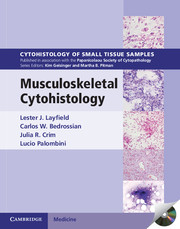Book contents
- Frontmatter
- Contents
- 1 Principles and practice for biopsy diagnosis and management of musculoskeletal lesions
- 2 Ancillary techniques useful in the evaluation and diagnosis of bone and soft tissue neoplasms
- 3 Spindle cell tumors of bone and soft tissue in infants and children
- 4 Spindle cell tumors of the musculoskeletal system characteristically occurring in adults
- 5 Giant cell tumors of the musculoskeletal system
- 6 Myxoid lesions of bone and soft tissue
- 7 Lipomatous tumors
- 8 Vascular tumors of bone and soft tissue
- 9 Pleomorphic sarcomas of bone and soft tissue
- 10 Osseous tumors of bone and soft tissue
- 11 Cartilaginous neoplasms of bone and soft tissue
- 12 Small round cell neoplasms of bone and soft tissue
- 13 Epithelioid and polygonal cell tumors of bone and soft tissue
- 14 Cystic lesions of bone and soft tissue
- Index
3 - Spindle cell tumors of bone and soft tissue in infants and children
Published online by Cambridge University Press: 05 September 2013
- Frontmatter
- Contents
- 1 Principles and practice for biopsy diagnosis and management of musculoskeletal lesions
- 2 Ancillary techniques useful in the evaluation and diagnosis of bone and soft tissue neoplasms
- 3 Spindle cell tumors of bone and soft tissue in infants and children
- 4 Spindle cell tumors of the musculoskeletal system characteristically occurring in adults
- 5 Giant cell tumors of the musculoskeletal system
- 6 Myxoid lesions of bone and soft tissue
- 7 Lipomatous tumors
- 8 Vascular tumors of bone and soft tissue
- 9 Pleomorphic sarcomas of bone and soft tissue
- 10 Osseous tumors of bone and soft tissue
- 11 Cartilaginous neoplasms of bone and soft tissue
- 12 Small round cell neoplasms of bone and soft tissue
- 13 Epithelioid and polygonal cell tumors of bone and soft tissue
- 14 Cystic lesions of bone and soft tissue
- Index
Summary
INTRODUCTION
Patient age has a significant impact on the diagnosis of musculoskeletal lesions. Many musculoskeletal lesions have characteristic ages of presentation. Thus, patient age can narrow the differential diagnosis in the evaluation of musculoskeletal tumors. Spindle cell lesions of the pediatric age group can be divided into those of similar appearance and behavior as adult lesions and those which occur only in infants and children or possess special morphologic features in the pediatric age group. These latter pediatric entities may possess morphologic features that do not reflect behavior when adult criteria are used for evaluation. In some of these processes, growth rate and morphologic appearance may suggest an aggressive neoplasm but in fact when occurring in the pediatric age group follow an indolent course. Hence, spindle cell lesions of adults and children will be discussed separately in this monograph.
Fibromatosis colli
Clinical features
Fibromatosis colli is a well recognized clinical pathologic entity occurring at a precise anatomic site (sternocleidomastoid muscle) and in a specific age group (infancy and childhood). Most cases present within the first few weeks after birth and are associated with muscular torticollis or wry-neck. Pathologically, it is similar to other forms of infantile fibromatosis but because of its unique clinical features is recognized as a separate entity. The lesion is relatively uncommon occurring in only 0.4% of live births. It is important to remember that the clinical finding of torticollis is not identical to the clinical pathologic diagnosis of fibromatosis colli. In fact, a majority of patients clinically presenting with torticollis will have entities other than fibromatosis colli.
- Type
- Chapter
- Information
- Musculoskeletal Cytohistology , pp. 23 - 40Publisher: Cambridge University PressPrint publication year: 2000

